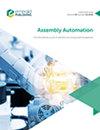FAOF: a feature aggregation method based on optical flow for gangue detection on production environment
IF 1.7
4区 计算机科学
Q3 AUTOMATION & CONTROL SYSTEMS
引用次数: 0
Abstract
Purpose The purpose of this paper is to improve the precision of gangue detection. In the real production environment, some gangue features are not obvious, and it is difficult to distinguish between coal and gangue. The color of the conveyor belt is similar to the gangue, the background noise also brings challenge to gangue detection. To address the above problems, we propose a feature aggregation method based on optical flow (FAOF). Design/methodology/approach An FAOF is proposed. First, to enhance the feature representation of the current frame, FAOF applies the timing information of video stream, propagates the feature information of the past few frames to the current frame by optical flow. Second, the coordinate attention (CA) module is adopted to suppress the noise impact brought by the background of convey belt. Third, the Mish activation function is used to replace rectified linear unit to improve the generalization capability of our model. Findings The experimental results show that the gangue detection model proposed in this paper improve 4.3 average precision compared to baseline. This model can effectively improve the accuracy of gangue detection in real production environment. Originality/value The key contributions are as follows: this study proposes an FAOF; this study adds CA module and Mish to reduce noise from the background of the conveyor belt; and this study also constructs a large gangue data set.FAOF:一种基于光流的生产环境脉石检测特征聚合方法
目的提高脉石检测的精度。在实际生产环境中,一些脉石特征并不明显,难以区分煤与脉石。输送带的颜色与脉石相似,背景噪声也给脉石检测带来了挑战。为了解决上述问题,我们提出了一种基于光流的特征聚合方法。设计/方法/方法提出了FAOF。首先,为了增强当前帧的特征表示,FAOF应用视频流的时序信息,通过光流将过去几帧的特征信息传播到当前帧。其次,采用坐标注意(CA)模块来抑制传送带背景带来的噪声影响。第三,用Mish激活函数代替校正后的线性单元,提高了模型的泛化能力。实验结果表明,与基线相比,本文提出的脉石检测模型平均精度提高了4.3。该模型可以有效地提高实际生产环境中脉石检测的准确性。原创性/价值主要贡献如下:本研究提出了FAOF;本研究增加了CA模块和Mish,以减少来自传送带背景的噪声;本研究还构建了一个大型脉石数据集。
本文章由计算机程序翻译,如有差异,请以英文原文为准。
求助全文
约1分钟内获得全文
求助全文
来源期刊

Assembly Automation
工程技术-工程:制造
CiteScore
4.30
自引率
14.30%
发文量
51
审稿时长
3.3 months
期刊介绍:
Assembly Automation publishes peer reviewed research articles, technology reviews and specially commissioned case studies. Each issue includes high quality content covering all aspects of assembly technology and automation, and reflecting the most interesting and strategically important research and development activities from around the world. Because of this, readers can stay at the very forefront of industry developments.
All research articles undergo rigorous double-blind peer review, and the journal’s policy of not publishing work that has only been tested in simulation means that only the very best and most practical research articles are included. This ensures that the material that is published has real relevance and value for commercial manufacturing and research organizations.
 求助内容:
求助内容: 应助结果提醒方式:
应助结果提醒方式:


